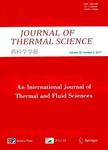Shock Wave-Boundary Layer Interaction in Forced Shock Oscillations
Shock Wave-Boundary Layer Interaction in Forced Shock Oscillations作者机构:Institute of Fluid-Flow Machinery Polish Academy of Sciences Fiszera 14Institute of Fluid-Flow Machinery Polish Academy of Sciences Fiszera 14Institute fur Stromungslehre Universitat Karlsruhe Kaiserstr. 12 80-952 Gdansk Poland 80-952 Gdansk Poland D-76128 Karlsruhe Germany
出 版 物:《Journal of Thermal Science》 (热科学学报(英文版))
年 卷 期:2003年第12卷第1期
页 面:10-15页
核心收录:
学科分类:08[工学] 080104[工学-工程力学] 0815[工学-水利工程] 0801[工学-力学(可授工学、理学学位)]
主 题:unsteady transonic flow shock wave nozzle flow.
摘 要:The flow in transonic diffusers as well as in supersonic air intakes becomes often unsteady due to shock wave boundary layer interaction. The oscillations may be induced by natural separation unsteadiness or may be forced by boundary conditions. Significant improvement of CFD tools, increase of computer resources as well as development of experimental methods have *** the attention of researchers to this topic. To investigate the problem forced oscillations of transonic turbulent flow in asymmetric two-dimensional Laval nozzle were considered. A viscous, perfect gas flow, was numerically simulated using the Reynolds-averaged compressible Navier-Stokes solver SPARC, employing a two-equation, eddy viscosity, turbulence closure in the URANS *** time-dependent and stationary flow simulations, Mach numbers upstream of the shock between 1.2 and 1.4 were considered. Comparison of computed and experimental data for steady states generally gave acceptable agreement. In the case of forced oscillations, a harmonic pressure variation was prescribed at the exit plane resulting in shock wave motion. Excitation frequencies between 0 Hz and 1024 Hz were investigated at the same pressure *** main result of the work carried out is the relation between the amplitude of the shock wave motion and the excitation frequency in the investigated range. Increasing excitation frequency resulted in decreasing amplitude of the shock movement. At high frequencies a natural mode of shock oscillation (of small amplitude) was observed which is not sensitive to forced excitement.



